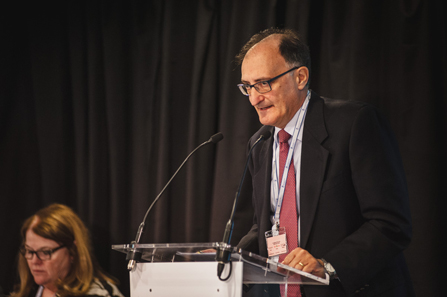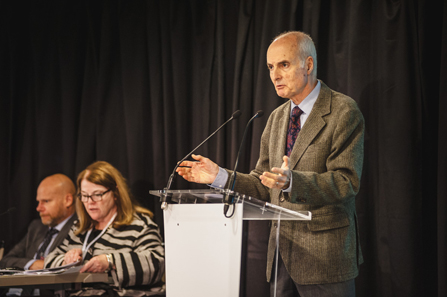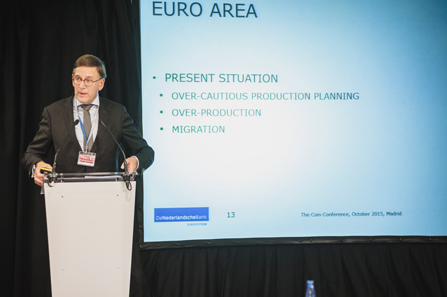[bsa_pro_ad_space id=4]
by Ursula Kampmann
translated by Annika Backe
November 19, 2015 – Between October 21 and 23, 2015, the Coin Conference took place in Madrid. In seven sessions, topics revolved around circulating coins. Logistics, security, cost efficiency, progress of cashless payment and sustainable mint management were at the center of attention. CoinsWeekly gives a brief summary of the lectures presented during the conference.
In the second part, we report on cash logistics.
Session 2/3: Optimizing cash logistics, management and distribution
Ferdinando Sasso, Banca d’Italia. Photograph: Reconnaissance.
Ferdinando Sasso, Banca d’Italia: Challenges and Solutions in Coin Circulation: the Italian Case
So far, Italian coin logistics was faced with a major problem. While 32 branches of the Banca d’Italia distributed coins, financial institutes could lodge their surplus coins only in the Rome branch. In addition, only one CIT (= Cash in Transit) company recirculated coins on a larger scale. The result was that the circulation of issued coins was limited to the local level. Furthermore, it was hard to balance shortages and surpluses in circulating coins.
As of late, the Banca d’Italia takes steps: it has created an internet portal where banks can exchange their circulating coins. The central bank acts as an agent who fixes the terms, for example the procedures involved in checking the coins for counterfeits, in organizing the packaging, and allocating the transport costs. For two weeks, demands and offers are posted; if no institution has shown interest in an exchange, the surplus coins can be returned to the Banca d’Italia at their nominal value.
Roberto Andrade, Banco de Espana. Photograph: Reconnaissance.
Roberto Andrade, Banco de España: The Spanish Coin Cash Cycle: Stakeholders, Evolution, Demand and Distribution
In his presentation, Roberto Andrade also addressed cash logistics, using Spain as an example. 16 % of all euro coins are currently circulating in Spain, with – as a phenomenon also common in other countries – the lower denominations (1 cents, 2 cents and 5 cents) constituting 63 % of the whole circulation.
Responsible for the annual mintage is the Spanish Treasury. The Spanish Central Bank proposes suggestions on the annual minting program, after which the Spanish Mint confirms the feasibility and, finally, the Spanish Treasury gives its approval. As the final step, ECB authorizes the total euro amount proposed for circulation and collector coins.
The coins are transported from the central bank or the mint to the CIT companies, to be distributed to professional cash handlers, such as commercial banks or main agents. Finally, the coins reach the general public. Surplus coins go the other way: from the general public to the distributor, from the distributor to the CIT company, and then from the CIT company to the central bank where the coins are checked whether or not they are fit for recirculation.
Ewout van Haeften, De Nederlandsche Bank. Photograph: Reconnaissance.
Ewout van Haeften, De Nederlandsche Bank: Forecasting and Stock Management
Forecasting is a difficult thing to do, as Ewout van Haeften made clear right at the beginning of his presentation. The reason for this is the fact that forecasts try to predict the future. No central bank, however, is spared the necessity to determine the country’s need for cash on the basis of experience. The most important tool for making an accurate prediction is a sound statistical analysis of the past. But a number of questions will remain: Will the population increase? Will there be any inflation? Will electronic payments change the demand for coins?
The immanent problem is the fact that it is impossible for a central bank to react immediately. The production of coins requires some time. Mints are commercial enterprises, bound to long-term contracts, which makes it hard for them to react quickly. Besides, before production can start, the required material has to be supplied first.
The only remaining option, therefore, is stockpiling. Stockpiling, on the other hand, is expensive. If there is too much material in stock, the only thing left to do is destroying it which generates even higher costs.
A central bank, therefore, has to carefully trade off excess against shortage in order to avoid bottlenecks, on the one hand, and high storage costs, on the other hand.
In the euro area, the present situation is far from ideal. There is an over-production despite excess stocks particularly in terms of the higher denominations. At the same time, the central banks still lack a top-level official exchange system that could provide the platform for a bank with a surplus of a certain denomination to accommodate another bank in need of the very denomination.
As a matter of fact, however, coins are currently ‘migrating’ unofficially. That is positive for the exporting country because it allows curbing surpluses. It is negative, in contrast, for the importing country because the migrating coins add to the existing circulating coins.
The EU thus witnesses the paradoxical situation that the very same denominations are simultaneously produced and destroyed. It takes improved planning and better cooperation to stop this cost-intensive process.
Louis Oro, Prosegur: Coin Cycle Efficiencies: A CIT Perspective of Usage, Handling and Logistics
In his presentation, Louis Oro presented a comparison of the logistic cycle of a banknote and a coin from the perspective of a CIT company.
He tracked the way of a 20 euro note and showed that of the 102 banknotes distributed by Prosegur only 100 are returned to the central bank. While the biggest share of cash is distributed to branches and cash machines, retail, on the other hand, hardly receives any banknotes at all. There is, however, a considerable high outflow of banknotes from retail.
As for coins, the situation is different: Prosegur distributes about the same amount of coins to banks and retail. While banks have a slightly bigger outflow than inflow, it is the other way round for retail.
In the Prosegur logistic centers, banknotes and coins undergo a fitness check to determine if they can continue circulating. Between 93 % (50 cents) and 100 % (5 cents) of all coins are recycled whereas for banknotes the share ranges between 15 % (10 euros) and 42 % (20 euros). The surplus of 1 and 2 euro circulating coins is also reflected in the way Prosegur deals with coins. The stock days of 1 and 2 euro coins amount to 600 after which the material has to be recycled. 1, 2 and 5 cent coins have 30 and 40 stock days. The 50 cent coin has the highest inventory and is stored as long as 610 days.
The stock days for banknotes, on the other hand, amount to 1.7 (50 euros) and 6.6 (200 euros).
Brian Lang, formerly Reserve Bank of New Zealand. Photograph: Reconnaissance.
Brian Lang, formerly Reserve Bank of New Zealand: Public Perception in Determining the Optimal Currency Structure
Brian Lang made an eloquent summation for abolishing the lower denominations. He started his presentation by making a few strategic remarks about the value of surveys in determining public perception. His main point was to not ask the people about their opinion but their daily life. In the case of New Zealand, the crucial question was put as follows: How many coins do you have in the household for day to day use, and how many coins do you store in jars or other places? How many coins do you put into storage each week, and how often do you empty out your store?
The result of the survey was that the general public of New Zealand places approximately ten times as many coins in a vessel of some kind than it actually spends. This finding matches the overall picture: 64 % of all euro coins in circulation consist of the lower denominations, 1, 2 and 5 cents. 54 % of the U.S. circulating coin production is made of 1 cent coins. In the UK, 1 penny, 2 and 5 pence pieces make for 75 % of all coins in circulation. Using these countries as a yardstick, annual worldwide coin production could be halved if the lower denominations were abolished. The retailers would benefit in that they would have to spend less resources on cash logistics.
As early as 1989, New Zealand eliminated the 1 and 2 cent coins while the 5 cent coin was eliminated in 2006. 68 % of the general public and 70 % of the retailers favored these measures. The effect on the prices was negligible.
Consequently, Brian Lang suggested that all other economies should follow the lead of New Zealand and eliminate the lower denominations.
All the other sessions of presentations you may find here:
Please find the first part, summarizing the presentations on trends and news coin series,
here.
This is the link for the conference attendees to download most of the speakers’ PowerPoint presentations.








